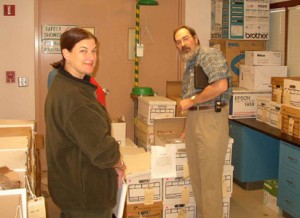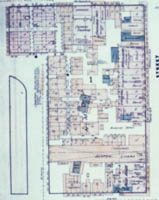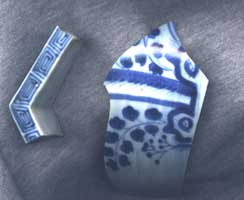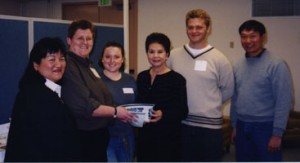
Alida Bray of History San Jose and Bill Roop of Archaeological Resource Service discuss the collection. Photo couretsy of ARS.
Working with a collection that was excavated nearly 18 years ago poses certain challenges. This week, many of our class activities were focused on reconstructing the original archaeological context of the artifacts we are analyzing. Since beginning work on this collection, we have been in close contact with the archaeological firm, Archaeological Resource Service, that conducted the excavation at the site of the Market Street Chinatown. In December 2003, we traveled to their office in Petaluma, where we meet with Bill Roop and Katherine Flynn and their staff and talked with them about the methods they used to conduct the excavation. This week, Bill and Katherine came to visit our lab at Stanford, along with one of their staff, Lisa Pefnichak. They brought two file boxes of original project records with them for us to use in our analysis of the collection.
Stanford graduate students Bryn Williams and Gina Michaels have also been working on developing a spatial context for the artifacts by developing an overlay of two maps: first, an 1884 Sanborn map of the Market Street Chinatown site, and second, a 1985 map of the location of the archaeological features that were excavated by Archaeological Resource Services. Sanborn maps were made for insurance companies to help them assess the risks of damage by fires and floods, so they often include very detailed information about how buildings were used what materials they were built from. For example, the 1884 Sanborn notes that the Chinese theater had “6 skylights, 2 protected by wire screens.” It also shows buildings like a furnace for roasting pork, a restaurant, and the locations of several stores. By overlaying the archaeological feature map, Bryn and Gina have been able to show that certain features were adjacent to certain buildings (Feature 28, for example, was a wood-lined cistern located right next to the Kong Family Store).
Artifact of the Week
As cataloging progresses, and more artifacts are entered into our database, we are able to rebuild a third kind of context: the associations between artifacts that were discovered in the same feature. Our artifacts of the week are several objects that were found together in Feature 28 and were presumably used by the owners and customers of the Kong Family Store. On the top row, from left to right, are a fragment of a cathedral-style glass bottle, often used for storing liquors (cat#85-31:28-32); a rim sherd of a medium-sized celadon porcelain bowl (cat#85-31:28-69); and a rim fragment from a hexagonal porcelain dish (cat#85-31:28-44). The middle row shows a clay marble (cat#85-31:28-12) and a fragment of a very small porcelain cup, decorated in the Four Seasons style (cat#85-31:28-107), that was probably used for drinking rice wine or liquor. The bottom row includes a bone toothbrush handle (cat#85-31:28-11) and a fragment from a porcelain bowl decorated in the bamboo style (cat#85-31:28-17).







